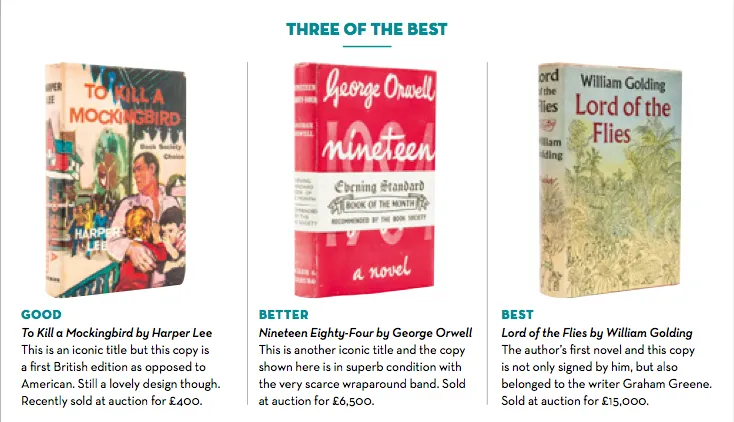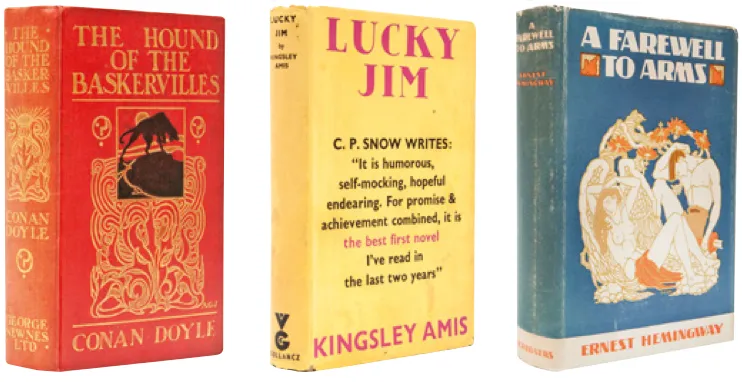How to identify first edition books and build a collection
In our expert guide on rare literary classics, Bloomsbury's rare books expert Max Hasler explains how to judge first edition books by their covers, what collectors are looking for and why you should invest.
Modern first editions comprise the fastest growing market in the book world. They attract both the well-off looking to build up an important collection and those with modest incomes hoping to have a nice edition of a book that they love.
I came into this area through my love of early 20th century literature: the thought of handling a book by the likes of James Joyce, Ernest Hemingway or TS Eliot in a similar state to when it first came off the press – let alone one that might have been handled or signed by the author him or herself – filled me with excitement.
How would you describe a ‘modern first edition’?
They are the classic titles by the greatest authors of modern English literature (that is literature written in English not necessarily by English authors.) They are mostly books written in the 20th century but include some authors from the late 19th century such as Sir Arthur Conan Doyle.
In collecting terms a ‘first edition’ refers to the very first ‘print-run’ or the first time a novel is published and offered for sale. Their numbers are by nature much smaller than later editions, which is what makes them so valuable.
Whose work are we talking about?
Think of the authors considered to be ‘greats’, so Graham Greene, F Scott Fitzgerald, Evelyn Waugh, Virginia Woolf, James Joyce, Ernest Hemingway, Agatha Christie, Daphne du Maurier, even Roald Dahl and PG Wodehouse.

How can you tell if a book is a first edition?
There are a number of different ways, but generally you are looking for what is not there: if the book in your hands mentions a ‘new edition’ or a ‘second printing’ then it is not a first edition. Another key element to check for in some books published after the 1970s (although not all) is a number line.
This is the line of numbers that appears on the back of the title page (not to be confused with an ISBN number). Generally the numbers will count down in order and you are looking for the lowest number to tell you which printing it is. The first edition of Harry Potter and the Philosopher’s Stone for example should read 10 9 8 7 6 5 4 3 2 1.
Why do people like collecting first edition books?
Obviously this can be personal – you may have particularly loved Catcher in the Rye, To Kill a Mockingbird or the works of JRR Tolkien, for example. Some people collect books based on the design of the dust-jackets, with many of these becoming as iconic as the books themselves.
You might also like first-edition James Bond books: are they worth collecting?
What affects the value of a first edition book?
Condition is paramount. To have a first edition is to see the book as it was originally intended to be – the better the condition, the closer it is to when it first came off the shelf. And it’s not just the condition of the book itself, as this only comprises about 10 per cent of the value.
That flimsy piece of paper that wraps around the book, the dust-jacket, is where most of the value lies. Not only is its presence key, but also its condition: a first edition with a fine example of the dust-jacket can fetch 10 times more than one without.
Another factor is the presence of an author’s inscription. Presentation copies can vary enormously in their appeal to collectors: an affectionate inscription to an important influence in the author’s life (for example, a family member, another literary giant, or a book-character inspiration) has more appeal than ‘to Joe Bloggs from the author’.
Is it just fiction that is popular with book collectors?
Generally, yes. There are a small number of non-fiction works that are sought-after – works by Maynard Keynes or James Watson’s The Double Helix. Poetry, on the whole, is not as popular as fiction, although certain poets such as TS Eliot, Seamus Heaney, and Philip Larkin are sought after. With the anniversary of World War I, war poets such as Wilfred Owen are very much in vogue.

Do films have an impact on the collectability of books?
Yes, very much so. Anything that pushes a book back into the public conversation will have a positive effect on the value. It’s not just films, though. Keynes’s books have seen a notable rise since the debate surrounding his work and the 2008 financial crash.
You might also like collecting vintage and antique books
What else do book collectors look for?
Collectors are keen on books printed before World War II in good condition, partly because they are so difficult to find, and partly because of the dust-jacket designs. Also, authors whose books were published in difficult circumstances are desirable.
George Orwell is a good example of this. He was a socialist who was closely monitored by the authorities (the Metropolitan Police Special Branch maintained a file on Orwell for more than 20 years). It was politically risky publishing his books so print runs were particularly small. As a result, many first editions of his books are extraordinarily difficult to find.
What’s the price range of first edition books?
For a copy in good condition by an author who will still be remembered (and therefore collected) in years to come, you should be looking at a minimum of around £100. Beyond that, first editions have been known to sell for hundreds of thousands of pounds.
Is there a holy grail for book collectors?
Arthur Conan Doyle’s The Hound of the Baskervilles has only appeared in a dust-jacket once on the open market, in 1998, when it made $120,000 (£77,000). If a copy came up now, it would almost certainly make more than $500,000 (£321,000).

What should new book collectors look for?
A good strategy is to go for the authors who are well-known and are already established as ‘greats’. Alternatively, you could collect works of greater significance to you personally or try to pick out the next JK Rowling or Ian Fleming – but this may not be the most lucrative avenue as you might get it wrong. Beware of collecting very modern first editions as print runs are larger than they used to be and the books may prove to be a flash in the pan.

How should people care for their first edition books?
Keep them upright or flat, out of direct sunlight, and in a stable environment free from damp that is, if possible, temperature-controlled and not near or above a radiator. It’s not a good idea to read or overly handle your first edition as finger-marks or tearing the dust-jacket will lower the value. In fact, it’s best to read a cheaper copy!
You might also like how to take care of antique books
What first edition books would you recommend investing in now?
Even though Harry Potter is making a lot of money now, there is a generation of people coming through who grew up with it – when they get to a collecting age you are likely to see the price peak again.
Any other advice?
Make sure you buy the true first edition. If the author is British you should generally make sure your copy was published in the UK; for an American author, look for US editions. The other thing to note is that the later the title in a series, the less valuable it will be, as publishers often increase print runs to cope with demand as an author’s reputation grows.
So, for example, while a first edition of Harry Potter and the Philosopher’s Stone is worth £15,000-£20,000, a first edition of Harry Potter and the Chamber of Secrets is only worth £400-£600 and Harry Potter and the Prisoner of Azkaban £200-£300.
My final words of advice are to ignore the old adage: make sure you do judge a book by its cover and always buy something you love.